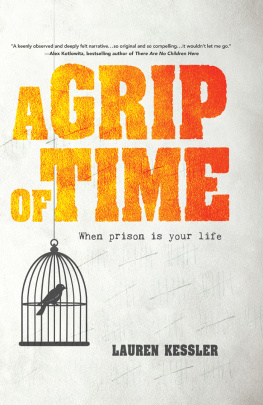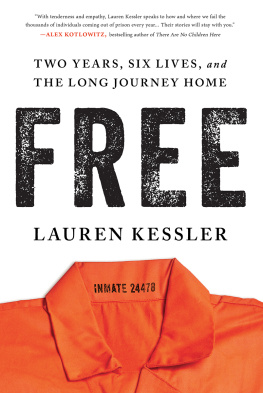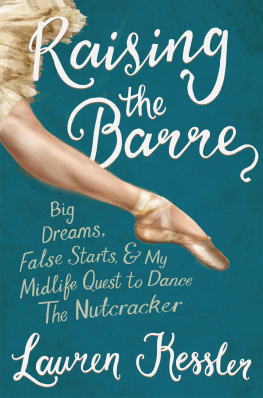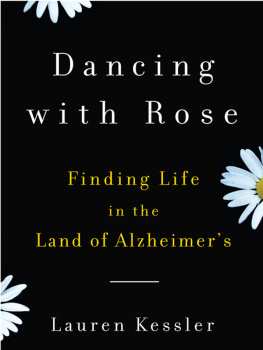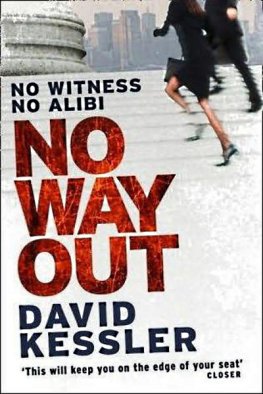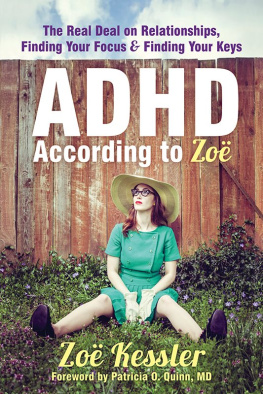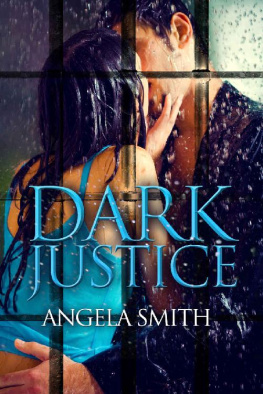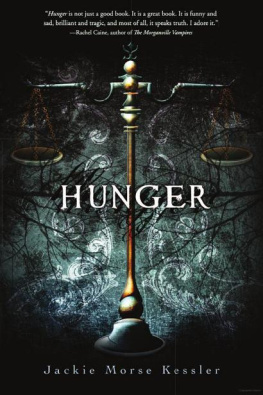Lauren Kessler - A Grip of Time: When Prison is Your life
Here you can read online Lauren Kessler - A Grip of Time: When Prison is Your life full text of the book (entire story) in english for free. Download pdf and epub, get meaning, cover and reviews about this ebook. year: 2018, publisher: Red Lightning Books, genre: Detective and thriller. Description of the work, (preface) as well as reviews are available. Best literature library LitArk.com created for fans of good reading and offers a wide selection of genres:
Romance novel
Science fiction
Adventure
Detective
Science
History
Home and family
Prose
Art
Politics
Computer
Non-fiction
Religion
Business
Children
Humor
Choose a favorite category and find really read worthwhile books. Enjoy immersion in the world of imagination, feel the emotions of the characters or learn something new for yourself, make an fascinating discovery.
- Book:A Grip of Time: When Prison is Your life
- Author:
- Publisher:Red Lightning Books
- Genre:
- Year:2018
- Rating:3 / 5
- Favourites:Add to favourites
- Your mark:
- 60
- 1
- 2
- 3
- 4
- 5
A Grip of Time: When Prison is Your life: summary, description and annotation
We offer to read an annotation, description, summary or preface (depends on what the author of the book "A Grip of Time: When Prison is Your life" wrote himself). If you haven't found the necessary information about the book — write in the comments, we will try to find it.
A Grip of Time: When Prison is Your life — read online for free the complete book (whole text) full work
Below is the text of the book, divided by pages. System saving the place of the last page read, allows you to conveniently read the book "A Grip of Time: When Prison is Your life" online for free, without having to search again every time where you left off. Put a bookmark, and you can go to the page where you finished reading at any time.
Font size:
Interval:
Bookmark:
Table of Contents
WRITING ABOUT PRISONS AND THE LIFE LIVED WITHIN THEIR walls depends first on access and then on trust, neither of which is easily granted. I get that. I get why it is easier to say no than to say yes. And before I found the people who said yes, I spent close to three years seeking out, attempting to cultivate, corresponding with, meeting, pitching, and repitching to many who said no. In that long process, Elizabeth A. Craig, head of the Oregon Department of Corrections (DOC) Office of Communications, lent her help and guidance. My thanks also to Joe Giblin, Elaine Shaw, and Tonya M. Gushard at the DOC for their early efforts on my behalf. Michele McCormack of Chemeketa Community College, with her tireless enthusiasm; Michelle Inderbitzen of Oregon State University, with her clear-eyed compassion; Melissa Buis Michaux of Willamette University, with her vision of restorative justice; and Steven Shankman and Shaul Cohen of University of Oregon, who created and nurture Oregon State Penitentiarys Inside Out program have all, with their integrity, hard work, and success, made my work possible. I owe them deep thanks.
The Lifers Club writing group owes its existencethis book owes its existenceto the optimism, energy, and tenacious support of one of the biggest yea-sayers I have had the pleasure to meet, Steven Finster, a recreation specialist at Oregon State Penitentiary (OSP). He put forth our proposals, argued for us at staff meetings, kept the channels of communication open, found a place for us on the calendar, was the brains behind the creation of the writing groups lifers book repository, helped me obtain my official ID, and through it all weathered the usual and unusual storms of bureaucracy with the persistence and strength of the navy vet he is. His boss at the time, Amy Pinkley-Wernz, said yes more than no, which made all the difference. (Her kindness toward Jimmie, I hope she knows, changed his life.) Activities colleague Patrice Lans not only took up the slack during Stevens absence but also spearheaded an extraordinary inmate-initiated project for a healing garden inside the walls. CO Cory Carter belied all the stereotypes youve read about or seen of uncaring (or worse, abusive) prison guards. His heart is as open and kind as his face. He brightened my day.
I thank the Playa Residency for two extraordinary weeks of focus and for reigniting my love of monotasking. Also for the sunrises. To Jody Swanson at Cloud & Leaf Books, profound appreciation for the house that has become my (our) writing retreat. To Scott Landfield at Tsunami Books, deep thanks for helping to provision the writers group with booksand for your never-say-die love of writers. To Marty Brown at Oregon State University Press, profound thanks from sixty enthusiastic OSP readers for making possible the donation of Stubborn Twig.
And also: to Sarah Blondin, whom I have never met, for speaking the truth in my ear; to Alex Kotlowitz and Ted Conover, for naming it, practicing it, living it (the journalism of empathy); to the crew at Food for Lane Countys Dining Room, especially Angie Godlasky, Josie McCarthy, Jesse Stafford, and Rene Speer, for modeling generosity of spirit, inclusion, and kindness; to Holly Lorincz, for long walks, longer talks, and understanding the joys and terrors of the work; to Keetje Kuipers, for bourbon, chocolate, and writerly camaraderie; to Kim Sheehan, for loyalty, support, encouragement, Americanos, and the ever-lasting warmth of true friendship.
I thank agent extraordinaire David Black for always believing and Jenny Herrera for her tireless (and I do mean tireless) efforts on the behalf of this book. I can hardly express the depth of my gratitude, Jenny. At Red Lightning, I thank my editor, Ashley Runyon, for her enthusiasm and support. I thank Darja Malcolm-Clarke, David Hulsey, and Michelle Sybert for their efforts on behalf of the book. At Amnet, I thank Leigh McLennon, Carol McGillivray, and Carmen Nickisch for their precision and care. It may not take a village, but it did take all of you.
I thank Trevor Walraven for showing me, the guys, and the system what is possible. I thank, with heart and soul, the men of the Lifers Club writers group, to whom this book is dedicated. You let me into your world. You trusted me. You educated me. You changed me.
And to my family: Liza Burns, for donating her design talents to the State Street Project; Jackson Hager, for years of computer crisis interventions; Zane Hager, for opening my mind and heart to restorative justice; Lizzie Hager, for showing me that strength and forgiveness go hand in hand. And Tom, partner and coconspirator in all. Grazie mille.
LAUREN KESSLER is an award-winning author and immersion reporter who combines lively narrative with deep research to explore subcultures in our midst, from the gritty world of a maximum-security prison to the grueling world of professional ballet; from the hidden world of Alzheimers sufferers to the stormy seas of the mother-daughter relationship. She is author of ten works of narrative nonfiction. Her other work includes Raising the Barre: Big Dreams, False Starts and My Midlife Quest to Dance The Nutcracker; Counterclockwise: My Year of Hypnosis, Hormones, Dark Chocolate, and Other Adventures in the World of Anti-Aging; My Teenage Werewolf: A Mother, a Daughter, a Journey through the Thicket of Adolescence; Pacific Northwest Book Award winner Dancing with Rose (published in paperback as Finding Life in the Land of Alzheimers); Washington Post bestseller Clever Girl; and Los Angeles Times bestseller The Happy Bottom Riding Clubwhich David Letterman, in fierce competition with Oprah, chose as the first (and only) book for the Dave Letterman Book Club. She is also author of Oregon Book Award winner Stubborn Twig, which was chosen as the book for all Oregon to read in honor of the states 2009 sesquicentennial.
Her journalism has appeared in the New York Times Magazine, the Los Angeles Times Magazine, O magazine, salon.com, the Utne Reader, The Nation, newsweek.com, Prevention, Ladies Home Journal, and elsewhere. Kessler lives with her family in western Oregon.
laurenkessler.com
laurenchronicles.com
MANY HAVE STUDIED INCARCERATION SOCIOLOGISTS , psychologists, criminologists, public health researchers, legal scholars, historiansand their work informed mine. A few journalists have managed to penetrate the walls surrounding prisons, and their work inspired mine. The best sources on the lives of the incarcerated are the incarcerated themselves.
Aiello, Antonio, and Jackson Taylor. Handbook for Writers in Prison. New York: PEN American Center, 2010.
Casella, Jean, James Ridgeway, and Sarah Shourd, eds. Hell Is a Very Small Place. New York: New Press, 2016.
Colsher, Patricia, Robert Wallace, Paul Loeffelholz, and Marilyn Sales. Health Status of Older Male Prisoners: A Comprehensive Study. American Journal of Public Health 82, no. 6 (June 1992): 88184.
Conover, Ted. Newjack: Guarding Sing Sing. New York: Random House, 2000.
Dumont, Dora, Brad Brockman, Samuel Dickman, Nicole Alexander, and Josiah Rich. Public Health and the Epidemic of Incarceration. Annual Review Public Health 33 (2012): 32529.
Earley, Pete. The Hot House: Life inside Leavenworth Prison. New York: Bantam, 1992.
Evans, Jeff, ed. Undoing Time: American Prisoners in Their Own Words. Boston: Northeastern University Press, 2001.
Fuller, John. A Day in Prison: An Insiders Guide to Life Behind Bars. With Holly Lorincz. New York: Skyhorse, 2017.
Garbarino, James. Listening to Killers: Lessons Learned from My 20 Years as a Psychological Expert Witness in Murder Cases
Next pageFont size:
Interval:
Bookmark:
Similar books «A Grip of Time: When Prison is Your life»
Look at similar books to A Grip of Time: When Prison is Your life. We have selected literature similar in name and meaning in the hope of providing readers with more options to find new, interesting, not yet read works.
Discussion, reviews of the book A Grip of Time: When Prison is Your life and just readers' own opinions. Leave your comments, write what you think about the work, its meaning or the main characters. Specify what exactly you liked and what you didn't like, and why you think so.

